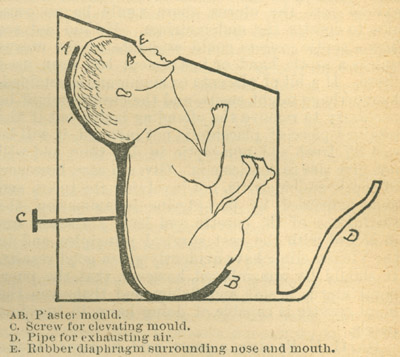Early Artificial Respiration
In 1782, the Royal Humane Society of England, a major participant in the European resuscitation movement, supported the use of bellows as the best means of inflation for artificial respiration. This method was widely supported internationally for over 40 years, until Leroy, of France, challenged its use in an 1829 memoir. Leroy criticized the lack of control in using bellows, and advocated a type of bellows which could be regulated for the specific patient's characteristics, such as size and weight.
As a result of this criticism, the bellows method lost support and went out of use around 1837. At this point, many people returned to basic methods of manual inflation and comfort assistance.3
Many methods of artificial resuscitation were developed during this period. Despite a wide variety of names, often reflecting the creator, almost all were focused on different medical emergencies that demanded artificial resuscitation, such as stillborn infants or chloroform asphyxia.4, 5
In 1889, Dr. O.W. Doe reported to the Obstetrical Society of Boston on the development of an infant resuscitator box by Dr. Egon Braun in Vienna. This early form of artificial respirator obtained a pressure seal by having the child's mouth pressed against a rubber diaphragm opening, while the rest of the body was entirely enclosed within the wooden box. The operator blew into the pipe to force the chest to compress, causing air to exhaust out of the pipe creating a suction that would expand the chest. This provided life-saving artificial respiration.
According to the report, the operator would repeat the process twenty to thirty times in a minute. Doe reports that Braun had used the artificial respirator device in fifty cases and was completely successful.6 In comparison to modern respiration devices, this early model only lacked a system of regulation and automation.
There were a number of additional early experiments with artificial respiration devices. In 1832, Dr. John Dalziel of Scotland developed a box to ventilate a "drowned seaman." Dr. E.J. Woillez designed an artificial respirator in 1876 that was said to have looked and operated much like the Drinker or Emerson iron lung. The great American inventor Alexander Graham Bell even built a test version "vacuum jacket" in the 1880s with hand-operated bellows much like those on the iron lung. In 1918, the South African Dr. W. Steuart came closest to developing a machine most like the ones that later made Drinker and Emerson famous. Steuart's machine was a sealed wooden box made specifically for treating poliomyelitis that operated by variable-speed, motor-driven bellows. Although his machine was supposedly a great success, the work was never formally reported and therefore became largely forgotten. Only a year later, Tulane University physiologists Felix P. Chillingsworth and Ralph Hopkins developed and tested a dog plethysmograph which produced ventilation by means of an electric pump that produced rhythmic variations in pressure. This device could have operated as a respirator had it been fully pressurized with a neck seal.7, 8
